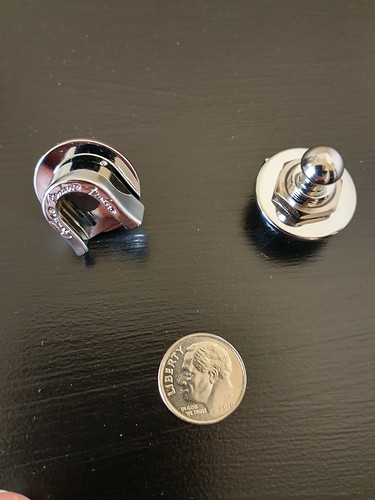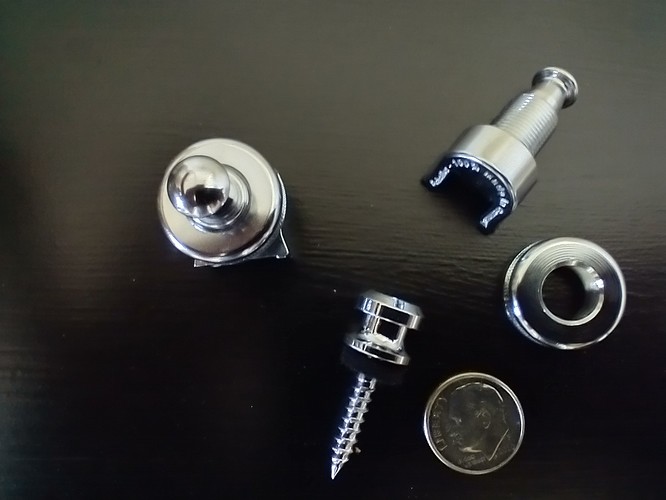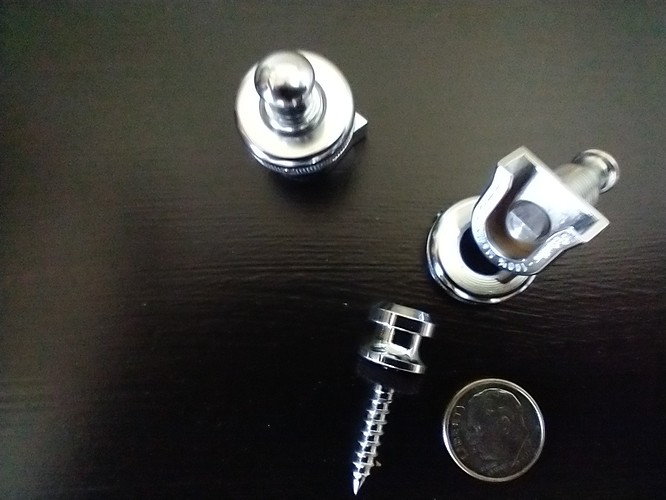UPDATE #5: Final Thoughts and Conclusion
After receiving the Schaller-S locks, I compared them to the locks that came with the Ultra bass and found that they fit the strap buttons just fine. Not only that, but they also fit the Fender “American Series” strap buttons (which did not work with those Ultra strap locks). The Schaller locks are of better quality than the Fenders because of the metal vs the plastic tooth, and although it’s a little hard to see in the photos, they also came with black felt pads attached to the screws which are part of the strap buttons:
Fender Strap Locks as supplied with the Ultra:
Schaller Strap Locks purchased separately:
CONCLUSION:
In general, the Squier VM Jazz Bass and the American Ultra Jazz (in passive mode) play the same, feel the same, and sound the same. As I mentioned several days ago, I was surprised that there wasn’t much of a difference between a $400 and an $1800 bass guitar in those regards. I switched back and forth between them several times to verify that.
But once the Ultra is in active mode, it is a clear winner in both volume and tone!
The major improvements of the Ultra over the Squier include:
— 3 band 18v preamp
— switchable active/passive modes
— high mass bridge
— noiseless pickups
— compound radius and satin finish neck
— 21 frets (providing 4 octaves E1 to E4)
— sculpted neck heel
Add to that the more aesthetically pleasing “special” color, better detailing with the white binding along the neck, fancier-looking tuner keys, the tool pouch, hardshell case, and the above mentioned strap locks.
For a ~$400 bass guitar though, the Squier is hard to beat. I would definitely recommend it to anyone from a beginner to an advanced player. (Don’t forget our Trusty Bass Teacher uses his regularly in videos and in lessons! ![]() ). It can also be upgraded with any number of parts, and I may try doing that at a later date.
). It can also be upgraded with any number of parts, and I may try doing that at a later date.
Minutiae: As I had also mentioned, after playing the Ultra for 10-11 days and then switching back to the Squier, I was just able to detect some differences in the neck. Lots of people do not like a glossy neck vs a satin finish, but I had no real preference one way or the other. (Then again, I haven’t played outdoors on a hot day either). I do think that the “Modern D” shaped neck felt more comfortable than the C neck on the Squier, and the sculpted neck heel is slightly better at allowing better upper fret access than the block-shaped heel found on the Squier. One very minor complaint I have about the Ultra is the location of the cable jack along the bottom edge of the body vs the control plate on the Squier, but this is because of the preamp. YMMV in any of these regards.
However, the burning question still remains:
“Is the Ultra really worth four to five times the cost of the Squier?”
It’s my position that Fender has farmed out construction to foreign manufacturers to save on labor costs, increase profits, and yet still be able to offer a low enough price point to attract buyers. So, American labor costs are the chief reason for the higher price, but it is generally agreed that the quality of the American product is higher. @JT has brought up a number of excellent points about pricing in the Fender Custom Shop - #2 by JT topic, and I won’t go into them here, but it’s definitely worth a read.
Touché, John . . . ![]()
This is true, but the American Ultra Jazz Bass has been a bucket list item for me, and I’m fortunate enough to be able to afford it. I’m also very happy with it. Unless you have fairly deep pockets, I would advise giving it a lot of thought, and trying it out in person, before purchasing one yourself.
Thanks to everyone for following this topic . . . I hope it may be of value to others.
Cheers
Joe


